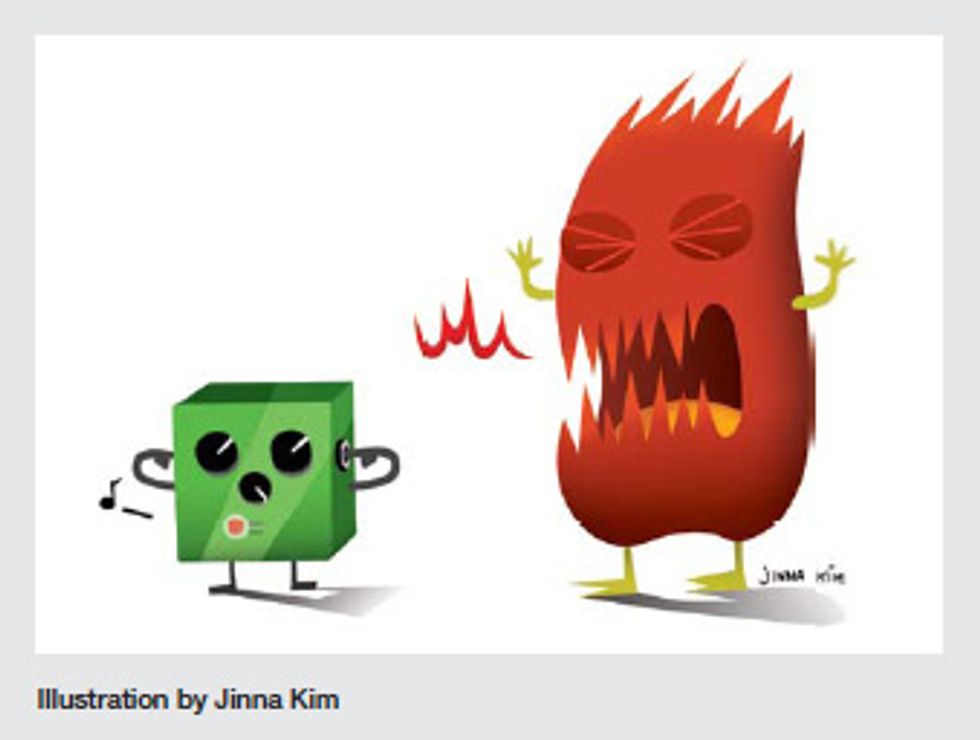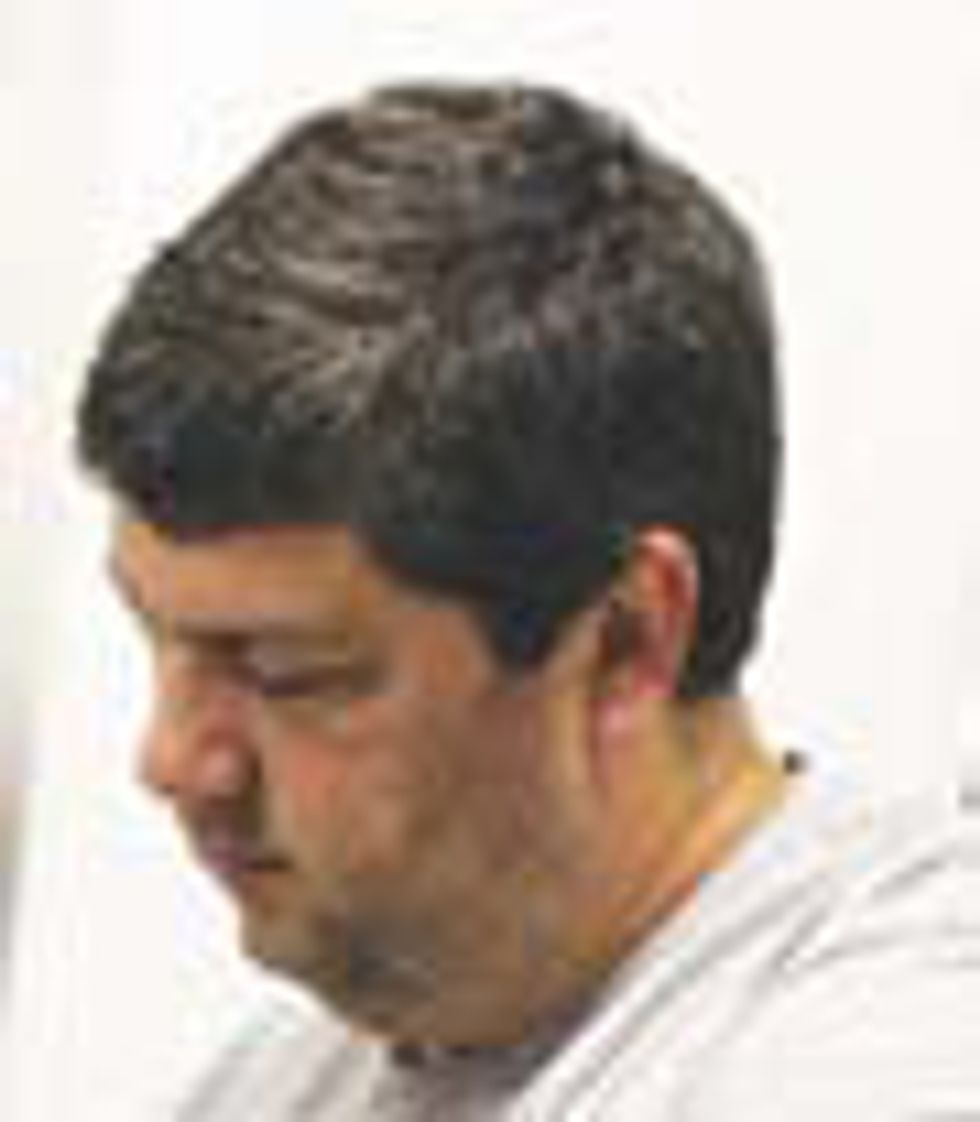When asked to define pornography,
Justice Potter
Stewart said, in effect, “I can’t
tell you what it is, but I know it
when I see it.” Noise in audio systems
is similar. It may be hard to
describe, but we all know it when
we hear it. Let’s take a look at
noise in guitar rigs and see how
we can reduce and control it.
We can classify noise into
two categories: random and
periodic. Hiss is a common
term for random noise. Periodic
noise has one or more frequencies
or tones that stand out.
Hum from AC power lines is
a periodic noise source. If we
effect designers design systems
carefully, we can eliminate
periodic noise because we know
something about it in advance.
Hiss is basically built into the
components we use to create
electronic products, and thus it
is here to stay. Like many things
that irritate us, we can’t eliminate
it, but we can manage it.

Before we can apply this knowledge to our rig, it will be useful to discuss one more bit of tech stuff. (Don’t worry if the nerd level of this section is out of control—practical examples are ahead.) Let’s look at a pedalboard as an example. At the output of each pedal, the noise from the previous pedal is added to the internal noise of the current pedal. The never-ending addition of noise would be worse if not for the curious property that two random, uncorrelated noise sources add up as a vector sum. To add two noise sources, each source is like the side of a right triangle and the sum is like the hypotenuse. So, instead of 1+1=2, we get something like 1+1=1.4 and 1+1/2=1.1. If we look at this in dB, we can take away two useful benchmarks:
Adding a pedal that has as much noise as everything before it will result in increasing the total noise by 3 dB.
Adding a pedal with half as much noise as everything before it will increase the total noise by only 1 dB.
“Where’s the fuzz?” When it comes to noise in guitar rigs, the most critical component is anything that adds gain. Adding gain is another way of saying, “Make it louder.” Overdrive, distortion, and fuzz pedals, as well as your amp, are among the devices that do this. As far as noise is concerned, they are all pretty much the same: They take the guitar signal and make it louder up to the point at which they clip off the tops and bottoms of the signal to create distortion. We hope that the noise signal is small enough that it won’t clip, so even though the guitar signal might not seem to get louder because it is clipped, the noise will definitely get louder. A typical overdrive can add 40 dB of gain, and a fuzz might offer 80 dB or more.
Using what we learned a moment ago, we can make the following conclusion: If a pedal adds a significant amount of gain, the noise generated by everything before that pedal is critical and the noise generated by everything after it ... well, not so much.
“What order do I put my pedals in?” To minimize noise, the answer is easy: Put an overdrive or distortion pedal first and then the rest in any order you want. What about amp distortion? This is where you can use the effects loop. The preamp section of your amplifier plays the role of the overdrive/ distortion pedal, so to minimize noise connect the other effects between the send and return.
“How do I troubleshoot noise issues?” A common complaint is, “My distortion pedal is noisy and every time I turn it on, the noise gets louder.” A distortion pedal amplifies both the noise coming in and its own internal noise. To figure out who is being naughty and who is being nice, plug your guitar directly into the distortion pedal and then into your amp. Turn the guitar’s Volume knob all the way down. Note the noise. Next, mute the strings and turn the guitar’s Volume knob up. If the noise gets louder, then the pedal is only amplifying what is coming out of the guitar and the dominant source is the guitar. If the noise stayed the same, then the pedal is the dominant source.
“What about frequency response?” So far, we’ve ignored how a pedal’s frequency response affects the noise. Once our signal and noise have been joined for life, we can’t reduce one with out reducing the other. One thing we can do is take advantage of the fact that the most objectionable noise is at the very high end of the audio band. If we roll off some high frequencies—that is, turn the treble down—the reduction in noise may be worth the reduction in signal. This is a critical part of the design of a distortion pedal. If we cut too much, the sound is muddy. And if we cut too little, it is thin and “hissy.”
“Will a noise gate help?” When we’re playing nice and loud, noise is not much of a problem. Our signal-to-noise ratio (SNR) is high. We have lots of signal. The problem is the worst when we’re not playing— then we have no signal and all noise. What if we were to hire an assistant to turn down the gain whenever we stop playing? The noise gate is a more cost-effective method to achieve that goal. It senses when you’re not playing and turns down the volume for you.
Digital processors that model amps or distortion pedals usually build in a noise gate that can make a noisy system appear to be quiet. The fact that many younger players’ first amps are modelers with built-in gates sometimes results in a poor understanding of how gain impacts the noise in a rig. This can be frustrating when guitarists start putting together a pedalboard.
I can’t say we have even scratched the surface of noise in audio systems, but hopefully this will get you thinking and experimenting with developing an intuitive understanding of where the noise coming out of your speakers originated and how you can go about keeping it under control. Stay tuned for more ideas in the coming months.
 Gregg Stock
is
Senior Analog Guru and
Engineer at Strymon.
Gregg Stock
is
Senior Analog Guru and
Engineer at Strymon.













![Rig Rundown: AFI [2025]](https://www.premierguitar.com/media-library/youtube.jpg?id=62064741&width=1245&height=700&quality=70&coordinates=0%2C0%2C0%2C0)












 Shop Scott's Rig
Shop Scott's Rig